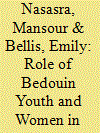|
|
|
Sort Order |
|
|
|
Items / Page
|
|
|
|
|
|
|
| Srl | Item |
| 1 |
ID:
190014


|
|
|
|
|
| Summary/Abstract |
This essay addresses the Israeli designation of “permanent residency,” more commonly known as Jerusalem residency to which Palestinians in occupied East Jerusalem are confined. Since 1967, the Israeli Ministry of Interior has revoked or refused to renew the residencies of nearly 15,000 Palestinians. Masquerading as a democracy, Israel hides behind the center of life doctrine—a set of policies and laws that require people to prove their lives center around Jerusalem, or areas occupied in 1948. Property deeds, rental contracts, employment papers, and utility bills are the documents Palestinians must produce to show evidence of belonging to Jerusalem. This bureaucratic wall of Israeli settler colonialism dispossesses Palestinians and employs fear to ethnically cleanse people who trace generations of ancestry to the city. The author shares her struggles in affirming her claims to Jerusalem and practicing sumud.
|
|
|
|
|
|
|
|
|
|
|
|
|
|
|
|
| 2 |
ID:
179082


|
|
|
|
|
| Summary/Abstract |
Naqab Bedouin resistance and political activism against the Israeli Prawer plans attracted attention in many local and international contexts and became a symbol of sumud [steadfastness] among Palestinians in Israel. In fact, the Bedouin, led at this time by motivated youth and women activists, showed greater creative, tactical and strategic agency and skills than politicians and scholars acknowledged in the past, and they actively contributed to shaping aspects of their own destiny within the state structure. We argue that creative, nonviolent, everyday and political resistance and activism, led by the young Bedouin [al-hirak al-shababi], succeeded in modifying and mitigating the Israeli Prawer Plan policies and strategies to relocate and expel the Bedouin from their historical villages. This study draws on a number of in-depth interviews in the Naqab with male and female youth, activists, and politicians. Specifically, it shows how Bedouin women and youth were key actors in resisting the Prawer Plan using social media tactics, which later led to Israeli withdrawal and freezing of the plan in 2013. The evolution of Bedouin resistance and the prevailing misrepresentation of the Bedouin is identified and tested through the case study of the anti-Prawer campaign and the Naqab Bedouin villagers’ on-going resistance to being forcibly relocated from their historical land in the Naqab.
|
|
|
|
|
|
|
|
|
|
|
|
|
|
|
|
|
|
|
|
|